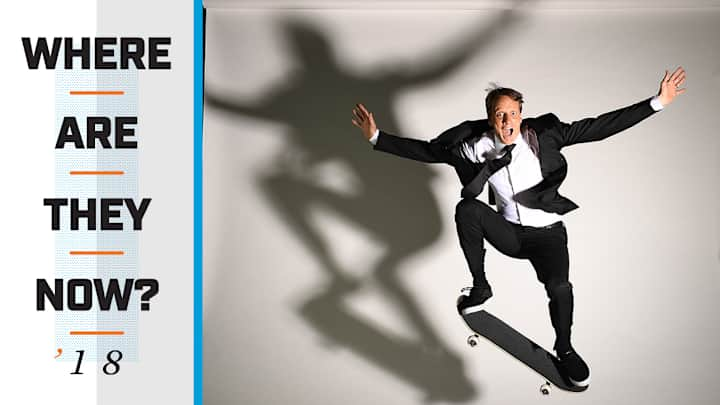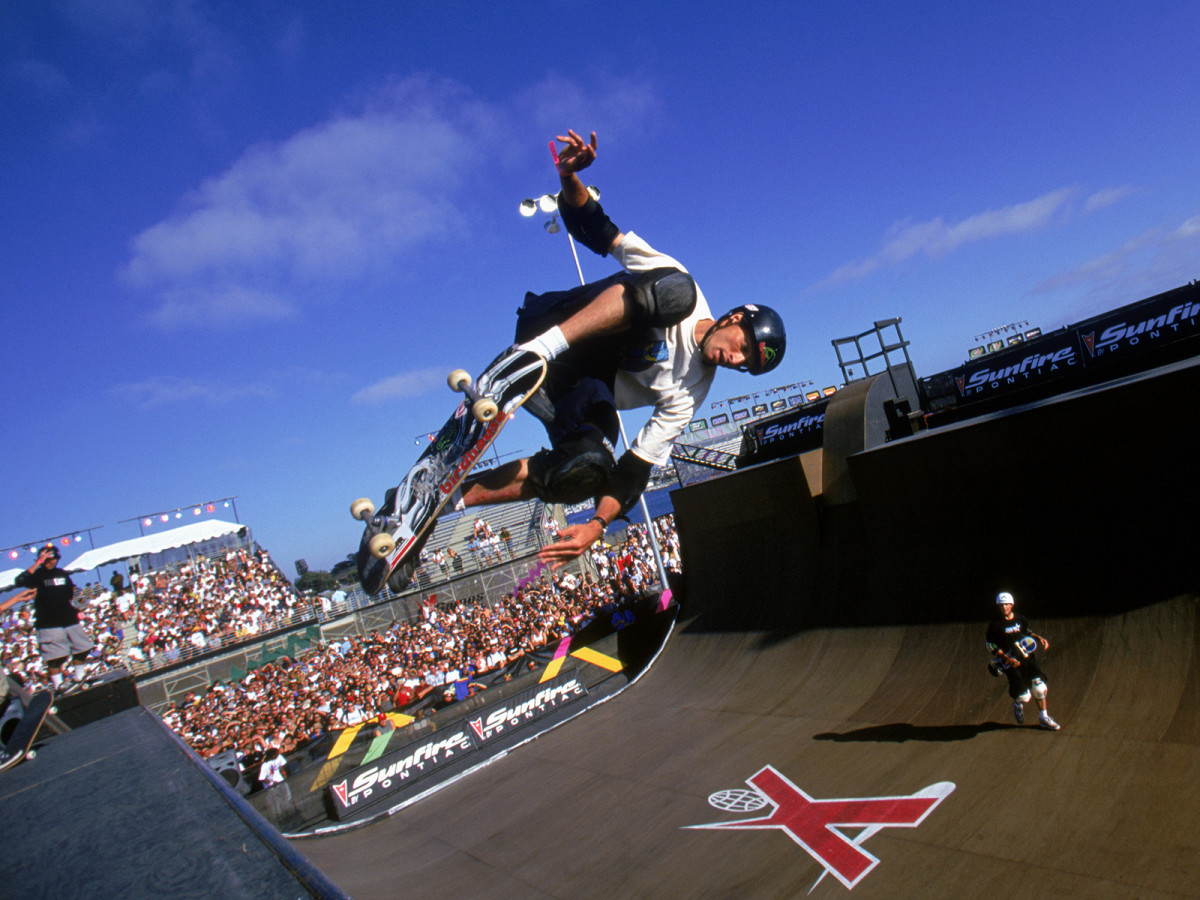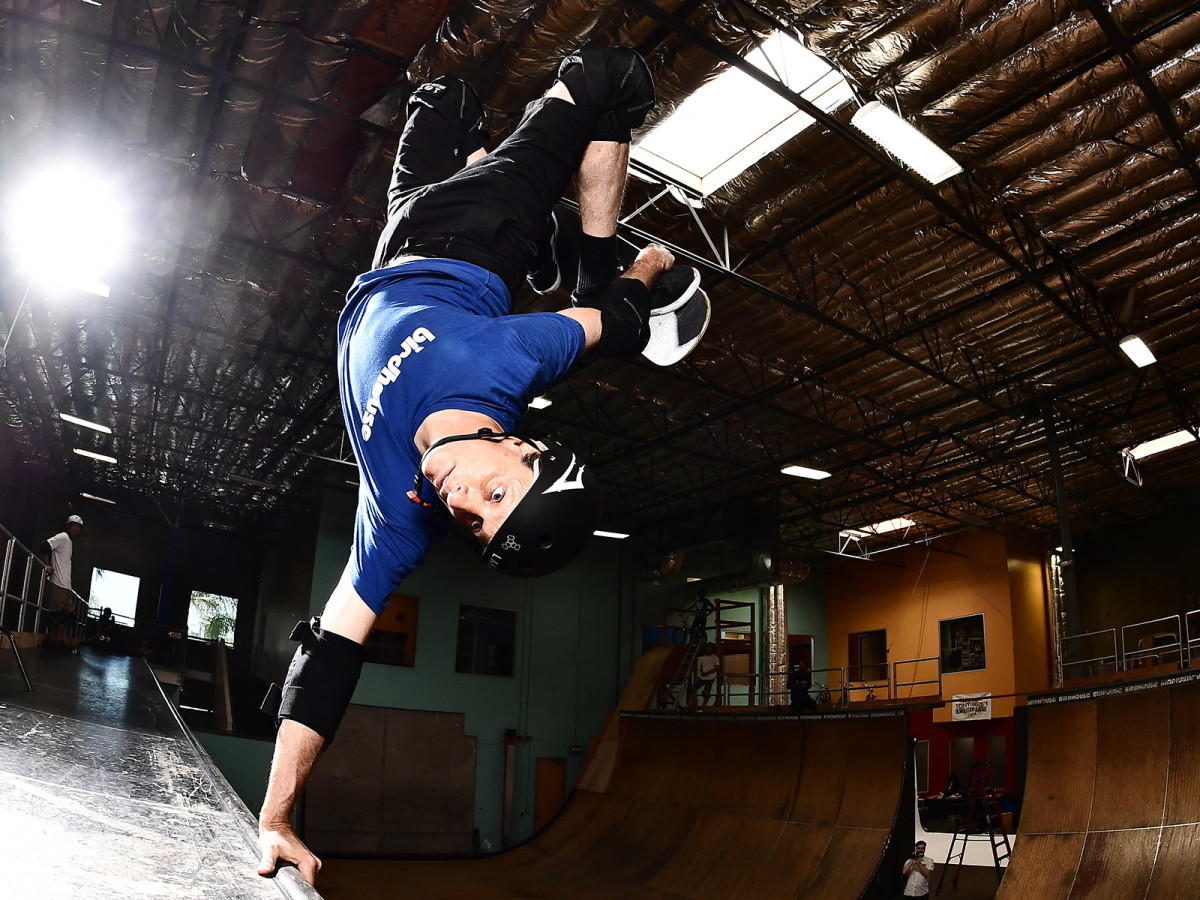How Does an Action Sports Superstar Age? Tony Hawk Is Figuring It Out on the Fly

This story appears in the July 2, 2018, issue of Sports Illustrated. For more great storytelling and in-depth analysis, subscribe to the magazine — and get up to 87 percent off the cover price plus two FREE gifts. Click here for more.
Watch Tony Hawk: Still in Flight, a new feature on SI TV that gives you an exclusive look at Hawk’s busy live and a tour of his private skate park.
***
For a minute, Tony Hawk is 15 again. Wearing a black jacket over a black button-down, hair swept across his forehead just like you remember it, he’s mouthing the words to Devo’s “Jocko Homo” in a dark club. The band’s frontman Mark Mothersbaugh gets to the chorus, which he has altered for the occasion:
Are we not men?
An-to-ni-o
Are we not men!?
The big 5-0
Hawk had started giggling, then cackling, when he walked into his surprise party in May at the Moroccan Lounge in L.A. and saw all that was in store for the evening. The kind words from three generations of skaters. The fact that Mothersbaugh would be performing, along with John Doe, Exene Cervenka and members of Love and Rockets. The HAPPY 50TH tattoo his friend and fellow skateboarding personality Jason Ellis had etched onto his side. On stage to thank Mothersbaugh, Hawk told the crowd of his closest friends, “I don’t think this is real life right now. I’m out of my mind in shock.” The bigger surprise went beyond the performers and the party details: Everyone was still rocking. “I can’t believe we’re all here together,” Hawk said to the group. “We made it this far.”
There is no script for how an action sports star should age, and it took Hawk a while to figure it out. Fifteen years ago, “Tony Hawk’s Pro Skater” swept the planet. The Boom Boom HuckJam tour took him around the country. He frequently appeared on MTV’s Jackass. He was living the celebrity life. “I never really wanted to be famous,” Hawk says, “but once it came, I thought, These are things that famous people do.” He’d go out drinking and perform hungover. “We’d have nights where I can’t believe he’d skate the next day,” longtime friend and skater Kevin Staab says. Other skaters would watch him and wonder how he could keep his eyes open, much less perform tricks only a handful of people in the world could pull off. An Advil devotee for most of his life, Hawk turned to prescription painkillers. He wasn’t addicted, he says, but he would take them after injuries and stay on the regimen for a while even after the pain was bearable. Then came a 2010 demo at Downtown Disney. Staab was on the top of the ramp that day as Hawk over-rotated on a 540 attempt, slamming onto his back. His helmet went flying up the opposite slope. Hawk curled up in a ball before limping off, using his skateboard as a crutch; he’d fractured his pelvis.

The injury forced him to take stock of his life, which now included four children from three different marriages. “I had been chasing whatever the dream was for too long,” Hawk says. “I still loved skating and the attitude of skating and the people of skating, and I just had to refocus. I made a realization: You’ve got to do what you love and be present for your kids.” And so Hawk finally came down to Earth, but on his terms.
On a sunny San Diego day, the party-boy version of Hawk is nowhere to be seen. He takes his nine-year-old daughter, Kady, to school, with a stop for pancakes on the way. They discuss the size of the lollipop Kady has been given for her part in an upcoming Willy Wonka Jr. production. Later he advises his oldest son, 25-year-old Riley, about the bathroom renovations that need to happen before the younger Hawk signs a lease for a coffee shop. “He doesn’t even have a business plan yet,” Hawk says. There are four more boys to manage: sons Spencer (19) and Keegan (16), and stepsons Miles (19) and Calvin (15), whose mom, Catherine Goodman, Hawk married in 2015. None of the kids answer group texts as quickly as Tony would like, so he yells on his way out the door that everyone needs to respond if they want anything from Rudy’s, the local taco shop, before telling Kady she’s got to put shoes on if she wants to go with him.
Hawk had been surprised by the scale of the party Catherine had thrown, but he’d known something was up that afternoon because the house was quiet. “The house is never quiet,” he says. The typical chaos returned late that night as Hawk scrambled to find a hotel room for Spencer at 2 a.m. so he wouldn’t have to make the two-hour drive home. The following morning, Hawk walked the streets of L.A. searching for Spencer’s car; it had been valeted at a restaurant instead of the hotel. So it goes. “It’s funny and real,” Hawk says. “I’m not complaining.”
But this is still Tony Hawk we’re talking about. The car he uses to shuttle the kids is a Tesla Model S with an all-white interior. Iggy Pop, the “godfather of punk”, plays on the stereo. When he and Kady get home on a Friday afternoon they inflate his Zorb, a human-sized ball with straps on the inside, so Hawk can push his daughter around their backyard skate park. Calvin carves around her on a skateboard. Next, Tony encourages Kady to try a frontflip on their trampoline, ultimately climbing on to show her how it’s done. He nails it on his first try. Then the idea of floating the Zorb in their infinity pool comes up. When Kady returns from putting on her swimsuit, she’s hesitant. “Catherine says it’s dangerous,” she reports. Calvin, now on his way to surf, weighs in: “Have you done this before?” Tony laughs. So maybe you can be a dad and a punk.

Bagel Boy, they called him, after Hawk endorsed Ore-Ida, maker of Bagel Bites. Sellout. But Hawk wanted to share his sport with a wider audience. So when ESPN, Sony or McDonald’s came calling, he saw each deal as an opportunity to get more kids on boards. The strategy worked. Skate culture went mainstream. Everyone wears Vans. Justin Bieber rides. And in Tokyo in 2020, skateboarding will make its Olympic debut. It doesn’t get more mainstream than that. Skateboard parks are popping up all around the country, a trend that The New York Times examined in an April story titled SKATEBOARDERS WON.
Hawk hasn’t slowed his efforts to grow the sport. He’s rolled around Brazilian favelas and on empty lots in Sierra Leone, and supported efforts to popularize skateboarding in Pakistan and Cambodia. Forty years ago, skateboarding was something close to a secret—a small community based almost exclusively in Southern California and Florida. It’s participants were scorned as troublemakers and druggies. Now it’s a global phenomenon. Hawk has fought—successfully—for kids to be able to skate just like they play soccer or baseball. And yet, he has stayed true to the culture’s roots.
For one, Hawk still lives north of San Diego, a few miles from his boyhood home and the Del Mar Skate Ranch, where he learned his first tricks. He even has a few tiles from that now-demolished site framed in his living room. Now, he skates every day he’s home on the vert ramp attached to Tony Hawk, Inc.’s office, with his finely tuned Pandora station—Tony’s Station Do Not F------ Delete—pumping out video game jams such as the Ramones’ “Blitzkrieg Bop” while skaters from that series (most often Staab) bang their boards against the wood whenever Hawk lands a trick he invented decades ago. “I’m doing this maybe better and more than I used to,” he says. He carries his sweaty gear to and from his car. When he breaks a board, he runs to find a new one. He doesn’t have any type of medical trainer at his facility, because stretching “would almost suck the fun out of it.”
Hawk retired from competition 18 years ago, and he couldn’t even tell you who won gold at the X Games—but when his stepson shows him an Instagram video of a pro nailing a frontside flip to frontside blunt side, Hawk is enthralled. That’s gnarly.
Ten years ago Hawk bought full control of the Birdhouse skate brand he created in 1993. He embarked on a five-year plan to make the line of skateboards and apparel one of the sport’s most respected brands. The eight skaters (seven men and one woman) on his team call him Dad, but when they’re on the road, he is more teammate than owner. They challenge him to S-K-A-T-E competitions. (He usually wins, but not always.) They wrestle with him in hotel rooms.
Hawk spent thousands to produce Saturdays, a 45-minute movie released in 2017 that highlights not only the skaters’ abilities but also their on-the-road high jinks and old-school camaraderie. It’s the kind of video that fans would have lined up to see in the 1980s, when Hawk was part of the famed Bones Brigade team. Hawk knew Saturdays wouldn’t be a profitable venture, but he still wanted his young Birdhouse skaters, who range in age from 25 to 31, to be a part of something like that.
Hawk is in talks to start his own marketing agency after nearly four decades of wrestling with others about how skateboarding should be portrayed. He’s working on a play with Mothersbaugh that would take the kickflip to Broadway. He’s also shopping a TV pilot based on a group of skaters.
In many ways, skateboarding has evolved past Hawk. His discipline—vert ramp—has been replaced by skaters doing tricks in venues that look more like obstacle courses. And yet he remains the sport’s public face. He led a push to make Apple’s skateboard emoji look more realistic. He hears about it when a skater on TV doesn’t wear a helmet. When a weird trick pops up online, Hawk is asked to weigh in on what it should be called.
“I’m a 50-year-old vert skater. I don’t represent all of skateboarding and how diverse it is,” Hawk says. “I’m happy to do so, but yeah, I’d love someone else to share the burden sometime, you know, or have another name. Other people deserve just as much recognition as I have.”

“When will Uncle Tony stop skating?” After the 50th bash, that’s what 16-year-old Cooper Mortimer asked his dad, Sean, who’s been friends with Hawk since Sean moved to California 30 years ago to chase his skateboarding dreams. Sean thought about it. Really, that should have happened a long time ago. Most skaters fall off pretty quick, but Tony’s still learning new tricks. “Honestly, I don’t know,” Sean responded. Still, Hawk has been thinking about what will happen to Birdhouse, as well as Tony Hawk, Inc. (an events and licensing company with 14 full-time employees), after he finally stops performing.
For much of the past year, Hawk skated alone on his ramp, without music, attempting to capture on film 50 of the tricks he’s created over his 50 years. He had to scrap plans to land a 360 flip to mute grab after a couple days of slams. It took an entire day of falls before he put down an extremely sketchy heelflip varial lien air, just getting his right toes onto the board in time to avoid a wipeout. “I was fully expecting to eat s--- coming down the wall,” he says. And the 720, the one mainstream trick he was persuaded to add to the video, took just as long. Immediately after landing one, he skidded through a gap on the ramp and flew into a pole. “Yes!” he yelled, before getting up slowly and testing his knees.
The video includes captions explaining which move Hawk is performing and when he created it. Three were developed in the last five years, including the final one, an alley-oop shove-it crooks to fakie, performed for the first time in that video. Hawk clearly doesn’t want to go out playing the hits. “When I first started skating, what drew me in was all the creativity involved—it was this blank canvas,” Hawk says to the camera, proving that innovators can be wistful too.
“Some of these will be the last time I do them,” he says, “but that’s O.K. It’s been a good run.”
Then the pro skater drops in, and the end begins.
